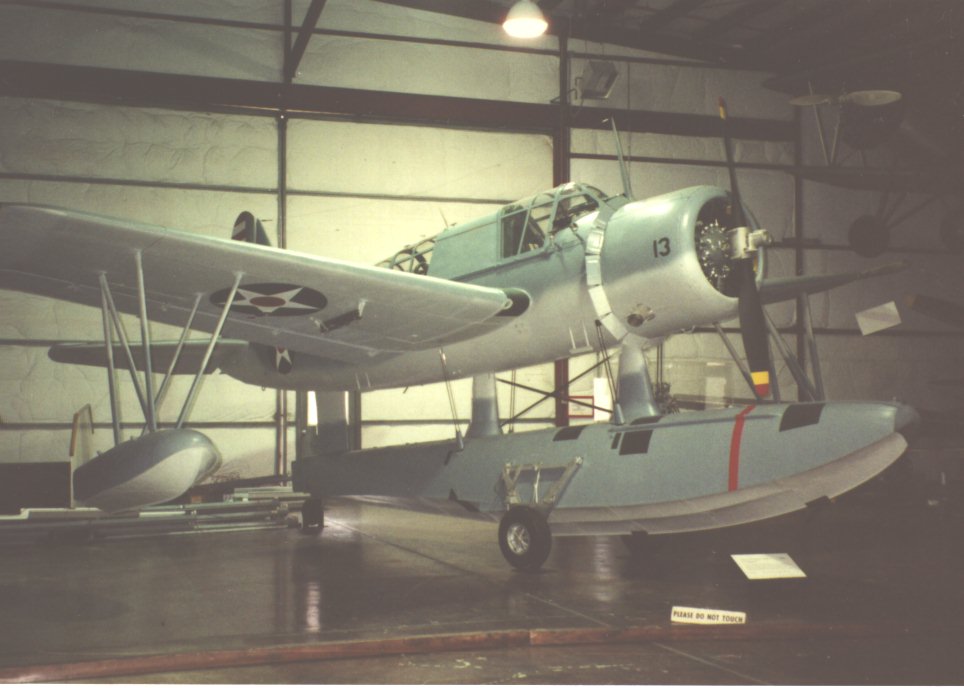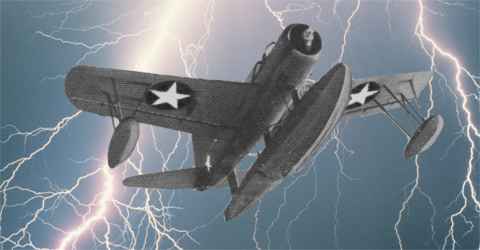OS2U Kingfisher

Manufacturer: Vought
Base model: OS2U
Designation: OS2U
Version: -3
Service: U.S. Navy / Marines
Basic role: Observation Scout
Designation Period: 1935-1945
Crew: Pilot and observer/gunner
Specifications
Length: 33' 10' (10.0 m)
Height: 15' 1" (4.6 m)
Wingspan: 35' 11' (10.6 m)
Wingarea: 262.0 sq ft (24.3 sq m)
Empty Weight: 4,123 lb (1,869 kg)
Gross Weight: 6,000 lb (2,721 kg)
Propulsion
No. of Engines: 1
Powerplant: Pratt & Whitney R-985-AN-2 or -8
Horsepower (each): 450
Performance
Range: 805 miles 1,296 km
Cruise Speed: 119 mph 191 km/h 103 kt
Max Speed: 164 mph 264 km/h 142 kt
Ceiling: 13,000 ft 3,962 m
Known serial numbers : 5284 / 5289, 5990 / 6289, 09393 / 09692
The plane flew for the first time on July 20, 1938, powered by a 450 hp Pratt and Whitney R-985-4 Wasp Junior radial air-cooled engine. It attained a maximum speed of 177 mph, and had a gross weight of 4,611 lbs. The float gear could be replaced by a fixed split-type landing gear.
After successful evaluation and some redesigning, production was begun for the U.S. Navy as the OS2U-1, and the first delivery of the plane was made on August 16, 1940. Fifty-four OS2U-I's were completed during 1940.
The OS2U-2's differed primarily in service equipment and in the engine, which was the R-985-50. The first two of an eventual 158 were delivered in 1940.
The principal production model, which appeared in the summer of 1941, was the OS2U-3. This model was externally similar to its predecessors but was powered by either the R-985-AN-2- or the -8 Wasp Junior. It featured 31 Imp. gallon self-sealing fuel tanks in the inboard sections of each wing, and 187 Ibs. of armor for the pilot and observer. Vought delivered 368 OS2U-3's in 1941, and an additional 638 were completed in 1942, when production was terminated. The British Fleet. Air Arm received 100 machines with float and wheel gear, entering service as Kingfisher I's. The Naval Aircraft Factory built 300 similar aircraft, designated OS2U-1. These were delivered to nine new Inshore Patrol Squadrons formed in 1942.
Based with the fleet, Kingfishers have ranged far and wide, seeing action in widely scattered war theaters. Lieutenant William F. Eadie piloted an OS2U-3 when he spotted and rescued Capt. Eddie Rickenbacher and his companions after they had virtually been given up as lost in the Pacific. That rescue forced him to taxi his over- loaded aircraft K miles in a rough sea with the most seriously injured trio member sharing the back seat with Radioman L. H. Boutte while Rickenbacher and his otner companion were lashed to the wings. This heroic action proved that the ruggedly built Kingfisher could take a beating from the sea and still deliver solid performance.




Examples of this type may be found at National Museum of Naval
Aviation, USS Alabama Battleship Memorial Park

